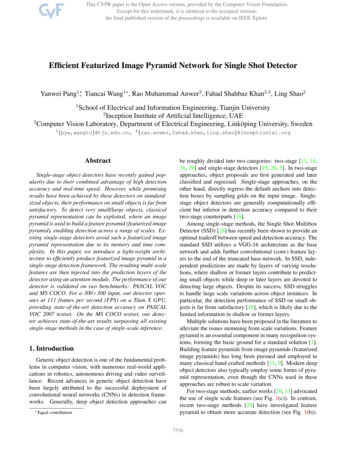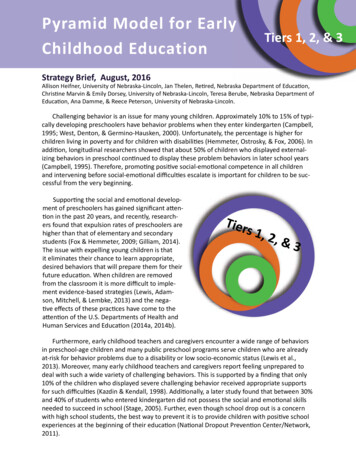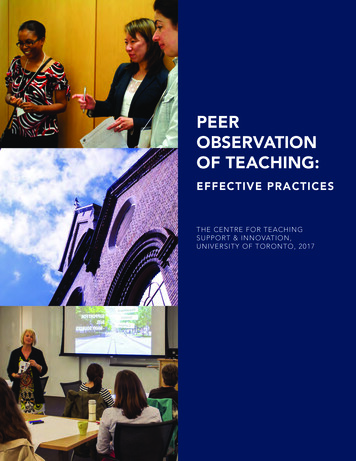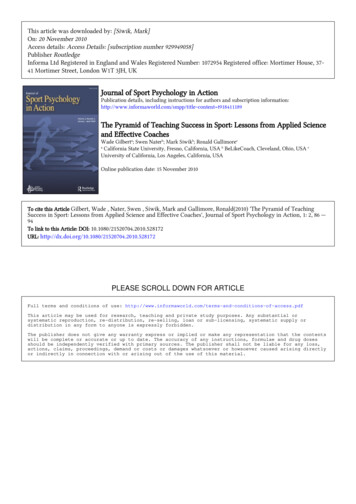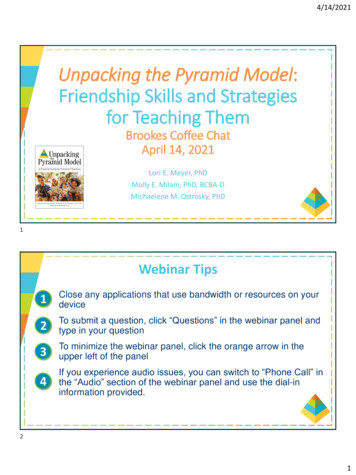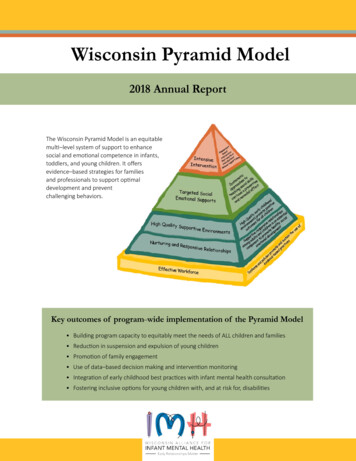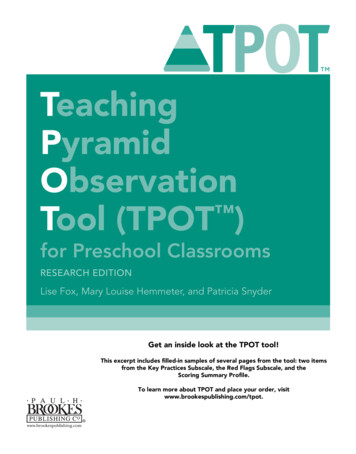
Transcription
TeachingPyramidObservation Tool (TPOT )for Preschool ClassroomsRESEARCH EDITIONLise Fox, Mary Louise Hemmeter, and Patricia SnyderGet an inside look at the TPOT tool!This excerpt includes filled-in samples of several pages from the tool: two itemsfrom the Key Practices Subscale, the Red Flags Subscale, and theScoring Summary Profile.To learn more about TPOT and place your order, visitwww.brookespublishing.com/tpot.
SUBSCALE 1: Key Practices1.Schedules, Routines, and ActivitiesINDICATORYESSR1Teacher has a posted classroom schedule of dailyactivities.XSR2Posted schedule is at children’s eye level andincludes visual representation of daily activities.XSR3Teacher-directed activities are 20 minutes orshorter.XSR4Both large- AND small-group activities occurduring the observation.XSR5Teacher reviews the posted schedule with childrenAND refers to it throughout the observation.XSR6Teacher structures activities so that there is a clearbeginning, middle, AND end.SR7A balance of child-directed AND teacher-directedactivities occur during the observation.SR8If needed, the teacher prepares children whenchanges are going to occur within the postedschedule. (Score N/O if you have no opportunityto observe.)XSR9Teacher only continues with a specific teacherdirected activity when the majority of children areactively engaged AND interested.XSR10Children who need extra support are prepared foractivities using an activity schedule OR individualized cues at the beginning of activities.XNOTES:NOELPMASTOTAL:XXN/O91- Removable daily schedule with photographs.- Good balance of teacher-directed and child-directed.- Circle and small group lacked a clear middle and end, some children seemed confused.Copyright 2014 Paul H. Brookes Publishing Co., Inc. All rights reserved.Do not reproduce without permission. 1-800-638-3775 www.brookespublishing.com3
SUBSCALE 1: Key Practices2.Transitions Between Activities Are AppropriateINDICATORYESTR1Teacher supports children’s transitions.XTR2Whole-class warnings are provided prior to themajority of transitions.XTR3Teacher has transition strategies that ensurechildren are actively engaged in the transitions.XTR4Teacher explicitly teaches children the steps ANDexpectations of transitions.TR5Teacher provides positive, descriptive feedbackto children who engage in a transitionappropriately.TR6Instruction to begin the transition is provided to achild in an individualized way.XTR7Teacher effectively guides individual childrenwho need extra support during the transitions.XTR8During transitions, the majority of children areactively engaged, including children who arewaiting for the next activity.NOTES:NONOTESELPMASTOTAL:XXX62- Feedback provided during transition was only corrective.- Children waiting for the art activity were not provided with anything to do and becamedisruptive4Copyright 2014 Paul H. Brookes Publishing Co., Inc. All rights reserved.Do not reproduce without permission. 1-800-638-3775 www.brookespublishing.com
SUBSCALE 2: Red FlagsRed FlagsThe following are “red flags” and may represent issues related to teacher training and support or to program policies andprocedures. To be scored Yes, the red flag should signify a problematic practice in need of immediate attention. Each redflag practice listed below is contraindicated in the Pyramid Model.PRACTICESYESNO15The majority of the day is spent in teacher-directed activities.X16Transitions are more often chaotic than not.X17Teacher talk to children is primarily giving directions, telling children what to do,reprimanding children.X18During group activities, many children are not engaged.X19Teachers are not prepared for activities before the children arrive at the activity.X20Children are reprimanded for engaging in disruptive or problem behavior (frequent use of“no,” “stop,” “don’t”).X21Children are threatened with an impending negative consequence that will occur if disruptiveor problem behavior persists.X22Teacher reprimands or admonishes children for expressing their emotions.23Emotions are never discussed in the classroom.X24Teacher rarely encourages interactions between children during play or activities.X25Teacher gives directions to all children in the same way without giving additional help tochildren who need more support.X26Teacher tells children mostly what not to do rather than what to do.X27Learning centers do not have clear boundaries.X28There are large, wide-open spaces in the classroom where children can run.X29Teacher reports asking for the removal of children with persistent challenging behavior fromthe classroom or program.X30Teacher makes comments about families that are focused on the challenges presented byfamilies and their lack of interest in being involved.X31Teacher restrains a child when engaging in problem behavior or secludes the child in anarea separate from the classroom where the child cannot see the activities of the classroom.XELPMASTOTAL:Copyright 2014 Paul H. Brookes Publishing Co., Inc. All rights reserved.Do not reproduce without permission. 1-800-638-3775 www.brookespublishing.com2X1525
SCORING SUMMARY PROFILE1/4/2014amDate: Start time: 9:00012345678911:30 amTeacher ID: End time:Observer ID:Directions: Write the number of items scored yes in column A and the number of items scored no in column B. Complete the calculations to derive apercentage score for each item.Subscale 1: Key PracticesA. Number ofindicatorsscored yesB. Number ofindicatorsscored noC. Totalpossible(A B)ELPMTPOT ItemScore(A / C * 100)91109062875Teachers Engage in Supportive Conversations with Children*810804Promoting Children’s Engagement*7229785Providing Directions527716Collaborative Teaming*729787Teaching Behavior Expectations617868Teaching Social Skills and Emotional Competencies718889Teaching Friendship Skills8198910Teaching Children to Express Emotions7188811Teaching Problem Solving6396712Interventions for Children with Persistent Challenging Behavior3256013Connecting with Families7188814Supporting Family Use of the Pyramid Model Practices61786922211481%2151712%1Schedules, Routines, and Activities*2Transitions Between Activities Are Appropriate3Total Key PracticesASSubscale 2: Red Flags15 – 31Red FlagsSubscale 3: Using Effective Strategiesto Respond to Challenging Behavior32. Using Effective Strategies to Respond to Challenging BehaviorNumber of incidents of challengingbehavior observed:2All essential strategies used ineach incident:Number of additional strategiesused:X No N/A Yes 1 2 3 4*This item includes N/O as a score option for one indicator. If the indicator is scored as N/O, exclude it from your counts of total Yes and total No.28Copyright 2014 Paul H. Brookes Publishing Co., Inc. All rights reserved.Do not reproduce without permission. 1-800-638-3775 www.brookespublishing.com
Pyramid Observation Tool (TPOT ) for Preschool Classrooms RESEARCH EDITION Lise Fox, Mary Louise Hemmeter, and Patricia Snyder Get an inside look at the TPOT tool! This excerpt includes filled-in samples of several pages from the tool: two items from the Key Practices Subscale, the Red

